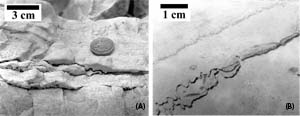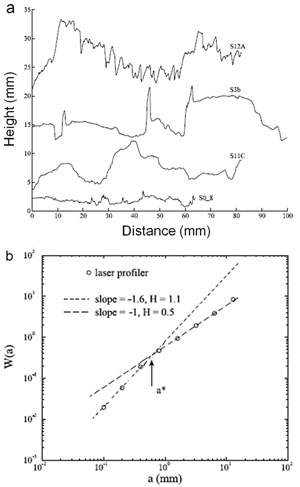| |||||||
|
|
|||||||
|
|
|||||||
| Pressure Solution Seam Roughness (Amplitude of Stylolites) | |||||||
|
A single stylolite, for example a bed-parallel pressure solution seam, is generally envisioned to begin as a planar surface and the amplitude of sutured columns is believed to be about equal to the thickness of rock dissolved (Figure 1, Stockdale, 1922). The amplitudes of stylolites are greatest at or near the stylolites' midpoints and decrease gradually to zero at the terminations, which is consistent with the notion that the greatest displacement discontinuity occurs at or near the middle of structure and it goes down to zero at the tip lines. For multiple stylolites in a given area, the thicknesses and amplitudes sometimes add up to a constant value along several scanlines, indicating the same amount of material removal. In Figure 1, the combined amplitude of the two branching or merging seams appears to be equivalent to that of the major single seam. Note that stylolite amplitude provides a minimum estimate of the material removal. The amplitude of a single stylolite has been used to estimate the shortening by pressure solution. Refer to the section on 'Strain of Pressure Solution Seams.' However, it has also been suggested that stylolite amplitudes decrease when they merge (Safaricz and Davison, 2005). Once the adjacent stylolites merge, the columns of former stylolites lying in the center of the seams collapse into one thick seam (Figure 2). Based on 3D quantification of the topography of stylolites in limestone (Figure 3a), Renard et al. (2004) and Schmittbuhl et al. (2004) proposed that stylolites have a self-affine scaling property. They concluded that stylolite surfaces have two distinct scaling regimes with two corresponding roughness exponents separated by a crossover length characteristic for all stylolites (Figure 3(b)) studied by these authors. Drummond and Sexton (1998) proposed that stylolites are fractal with a fractal number of 1.346. Peacock and Azzam (2006) reported that stylolite amplitude in limestone and dolomite obeys a power-law scaling relationship over 20 mm to 150 mm range (Figure 4a). Limestones and dolomites show similar scaling relationships, although the graph for dolomites is slightly steeper. This may be because stylolites are less developed and therefore, there are fewer seam mergers in the dolomites than in the limestones. Other data indicates that the relationship between residue thickness and stylolite amplitude is very weak (Figure 4(b)), presumably because of the merging of stylolites. Other factors impacting the seam roughness are the lithology, the distribution of inhomogeneity in rock, and loading (Andrews and Railsback, 1993; Ebner et al., 2010). | |||||||
| Reference: |
|||||||
| Andrews, L.M., Railsback, B.L., 1997 Drummond, C.N., Sexton, D.N., 1988 Ebner, M., Piazolo, S., Renard, F., Koehn, D., 2010 Koehn, D., Renard, F., Toussaint, R., Passchier, C.W., 2007 Peacock, D.C.P., Azzam, I. N., 2006 Renard, F., Schmittbuhl, J., Gratier, J.P., Meakin, P., Merino, E., 2004 Safaricz, M., Davison, I., 2005 Schmittbuhl, J., Renard, F., Gratier, J.P., Toussaint, R., 2004 Stockdale, P.B., 1922 |
|||||||
|
Readme | About Us | Acknowledgement | How to Cite | Terms of Use | Ⓒ Rock Fracture Knowledgebase |
|||||||



